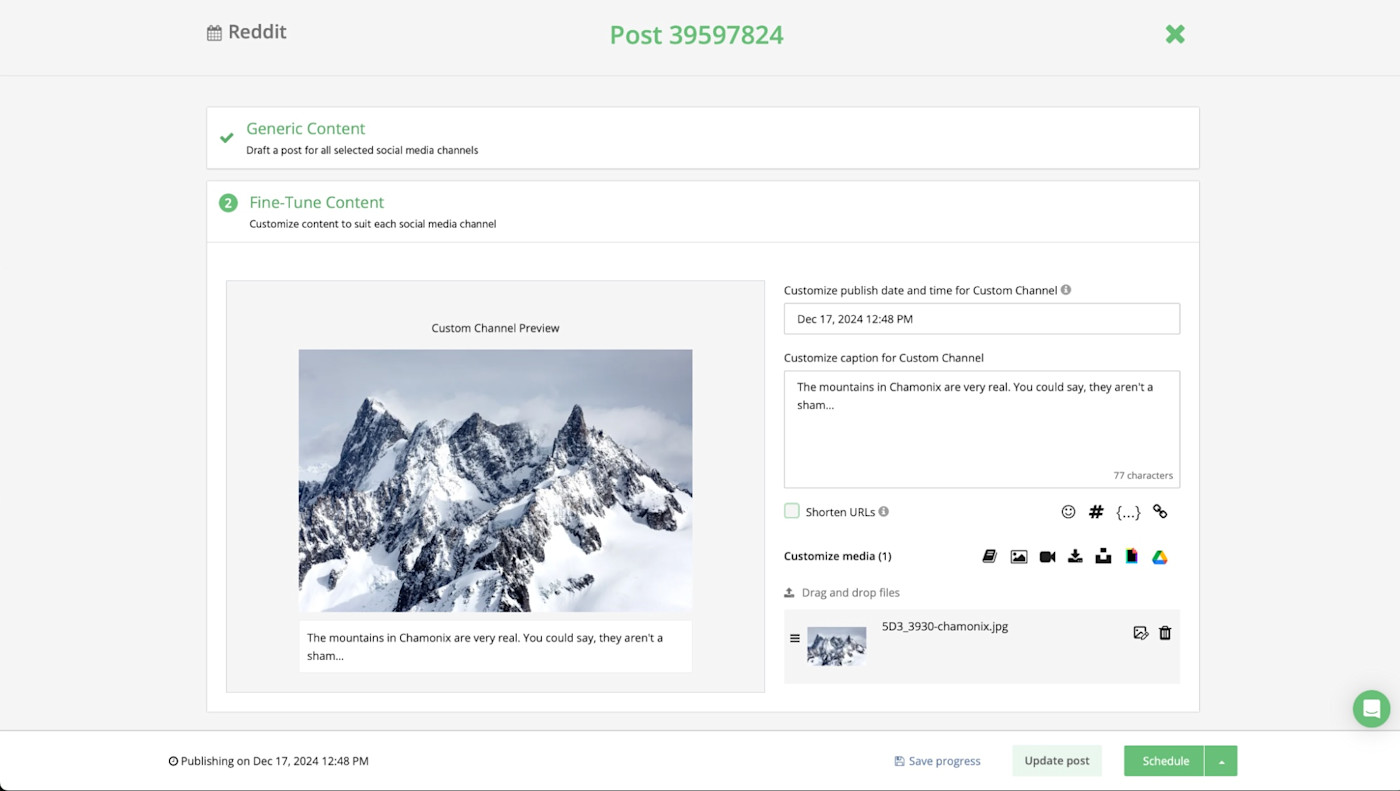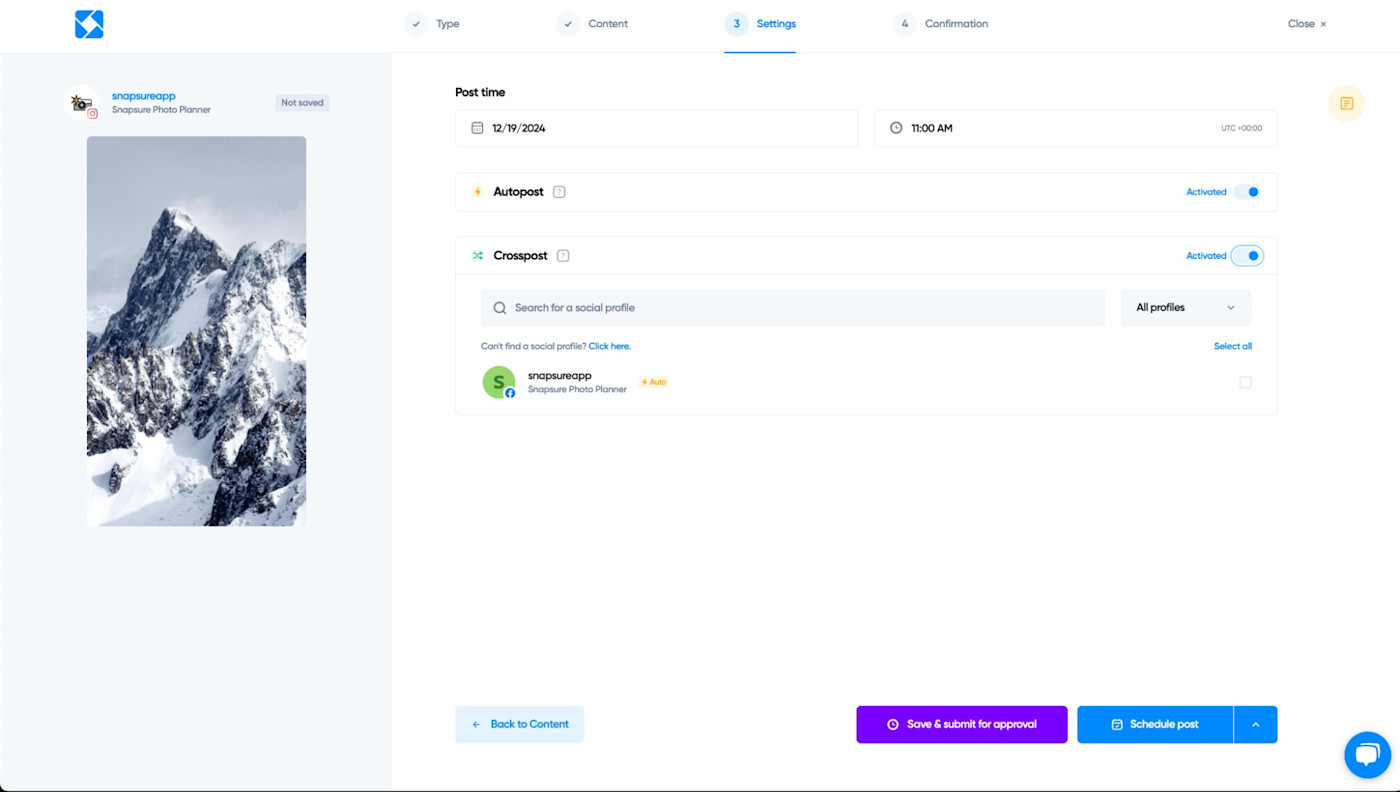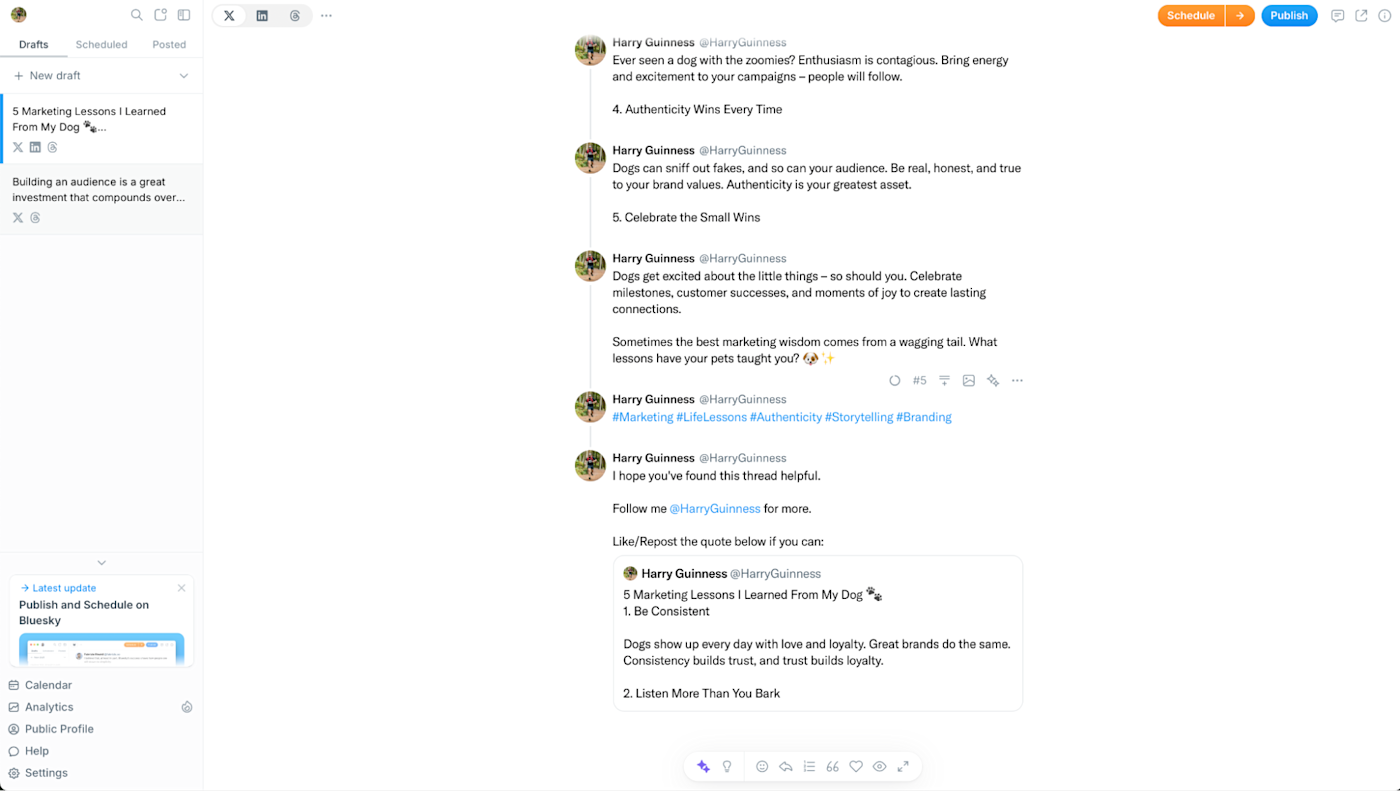Social media has been in upheaval for the last few years. Twitter is now X, AI is everywhere, Bluesky is a thing, and TikTok may be banned in the near future. Despite the chaos, social media is still one of the most powerful tools available to modern businesses. You can use it to find new clients, drive traffic to your site, and keep in touch with existing customers so that they stay engaged with your business. But with all the drama, the tools you use to keep on top of things are more important than ever.
With social media even more fractured than it was, if you aren't careful, you can waste huge amounts of valuable time trying to manage multiple inboxes across five different apps, post the same things on all the different platforms, and keep on top of everything else. It's next to impossible using regular consumer apps. To do it properly, you need a social media management app.
The best social media management tools allow you to control your full social media presence in a single app. You can automate, analyze, and manage social media accounts, so you can focus on creating the kind of content your audience loves. I put almost 70 social media management apps to the test, and based on my testing this year, here are the seven best.
The best social media management tools
Buffer for straightforward social media scheduling
Hootsuite for fully-featured social media management
Vista Social for small teams
Loomly for automating any social media service
Iconosquare for visual content
Typefully for text-based social networks
Sendible for an affordable all-in-one social media management app
Once you've picked a social media management app, you can make it even more powerful and efficient by automating it. Take a look at how you can use automation to improve your social marketing. Or, if you're focused on a specific platform, learn more about Facebook automation, Instagram automation, and LinkedIn automation.
What makes the best social media management tool?
How we evaluate and test apps
Our best apps roundups are written by humans who've spent much of their careers using, testing, and writing about software. Unless explicitly stated, we spend dozens of hours researching and testing apps, using each app as it's intended to be used and evaluating it against the criteria we set for the category. We're never paid for placement in our articles from any app or for links to any site—we value the trust readers put in us to offer authentic evaluations of the categories and apps we review. For more details on our process, read the full rundown of how we select apps to feature on the Zapier blog.
The problem with social media management software is that every app is limited by the same thing: the features the various social networks give it access to. This means that not only do most social media scheduling tools offer very similar features, but those features vary between the social networks they support. TikTok, for example, gives a totally different set of analytics data than Facebook, while Instagram is different to post to than YouTube.
And that's before we even talk about X-formerly-Twitter. Until Elon Musk bought it, it had one of the most permissive APIs. A lot of social media management apps relied on it to offer features like competitor monitoring and social media listening. But those kinds of features now cost around thousands of dollars per month, so they're only available in some of the most fully-featured enterprise apps or on the most expensive plans.
All this means that when it comes to the best social media manager software, you shouldn't expect wild standout features related to particular social networks. There's no social media management platform that can post directly to a personal Instagram profile or reply to comments on someone else's Facebook Page posts.
Still, there are some key features that the top social media managers have that set them apart. They generally make managing your business's social media presence easy and efficient. In particular, they offer:
Support for multiple social networks, ideally including Facebook, X, Instagram, and TikTok at the very least, though since things have become more chaotic, I've had to relax this criteria a touch. Similarly, support for Mastodon, Threads, Bluesky, and the other Twitter replacements is increasingly relevant. The goal with any of these apps is to manage as many of your social networks as possible in one app—or at least to manage a more focused bunch of them really well.
Powerful scheduling tools, so you could batch your social media posts at the start of the week or month, and then just let them run. (Access to your social media inboxes so you could reply to customers was a bonus, but not required for more affordable apps.)
Detailed analytics on how your posts do. The more expensive the app, the more powerful the analytics I required—at least until they hit the limit of what the social media apps offer. For enterprise apps, for example, I required more powerful X features like social monitoring, where you can scan for posts about your business, or even your competitors. More basic apps can't afford the API access these otherwise require.
Cost-effectiveness. With all social media software limited to offering the same kind of features, high prices need to be justified with additional features, stellar customer support, and team and collaboration tools.
AI also looks like it's going to have a huge effect on how companies manage social media, but for now, I wasn't super impressed with many of the apps that made a big deal of it. Most apps that allow you to schedule your posts already employ some kind of AI to find the best times, and the apps that aimed to write social media posts for you were all very similar, and not significantly better than using ChatGPT. If AI is a priority for you, check out Zapier's list of the best AI-powered social media managers. While many of the apps on this list have added AI features, they're all still tools that enable you to post whatever you want to social media—whether you, an AI, or an intern wrote it.
Every tool that made the list has a free trial—and sometimes even a free plan—so don't be afraid to dive in and try them out. The best social media management app for you will be the one that best fits your needs and price point.
I've been covering tech for over a decade and updating this list for the past four years, so I've spent a lot of time exploring and testing social media marketing software. After putting them through their paces, comparing the features and user experience they offer against other similarly priced apps, and generally assessing how good (or bad) they are to use, these seven social media planning tools are the ones I think will be the best fit for the majority of businesses.
The best social media management tools at a glance
| Best for | Standout feature | Pricing |
|---|---|---|---|
Straightforward social media scheduling | "Link in bio" service called Start Page | Free plan available; from $6/month per channel | |
Fully-featured social media management | Intuitive analytics | From $99/month | |
Small teams | Robust features at an affordable price | From $39/month | |
Custom sites | Custom social network allows you to post to any channel via Zapier | From $42/month | |
Visual posts | Great Instagram integrations | From $39/month | |
Text-based social networks | Great for Twitter alternatives | Free plan available; from $12.50/month (billed annually) | |
An affordable all-in-one social media management app | Nails the basics | From $29/month |
Best social media management tool for straightforward social media scheduling
Buffer (Web, iOS, Android)

Buffer pros:
Dead simple scheduling for all your social media accounts
Decent free tier and per-channel pricing keeps costs low for small businesses
Buffer cons:
Buffer has a history of changing up its pricing and features quite drastically
Buffer is one of the longest-running social media tools aimed primarily at scheduling posts, although it's gone through multiple updates, shifts, and iterations to keep up with the times. It now supports Facebook, X, LinkedIn, Instagram, TikTok, YouTube, Mastodon, Bluesky, Threads, Pinterest, and Google Business Profile. Free users can connect up to three social accounts, including Facebook Pages and groups, though you're limited to scheduling 10 posts for each channel.
While Buffer's free plan is good enough for small businesses to line up a week or so's worth of posts, if you want a more complete social media management solution or to control more than three social media accounts at once, you'll need to pay $6/month per social channel for the Essentials plan. This gives you access to detailed analytics and engagement features, which let you interact with your audience directly from Buffer—just don't expect to be able to reply to posts on X anymore. (Also, if you want to bring team members on board, Buffer goes up to $12/month per social channel.)
In addition to the core scheduling, analytics, and audience management features, Buffer also offers its own "link in bio" service called Start Page. It's not a new idea, but it's handy having it included as part of your social media management app. Similarly, the included Ideas Kanban board isn't revolutionary, but it makes sense to keep your in progress social media posts in your social media scheduling app.
Like many other social media apps, Buffer has added an AI Assistant. It can generate posts, rephrase your drafts, help you create ideas, and otherwise do all the other AI content generating you'd expect. You may find it nice to have, but Buffer has a lot more going for it.
With Zapier, it's easy to link any other service you use to Buffer. For example, you can automatically add new blog posts to your schedule, either directly from WordPress or through an RSS feed, or add new Instagram photos to Buffer. Learn how to automate Buffer with Zapier, or get started with one of these pre-made workflows.
Add new items in RSS feeds to Buffer as scheduled items
Buffer price: Free plan includes 1 user, 3 accounts, and 10 queued posts per profile; from $6/month per social channel for the Essentials plan that offers unlimited queued posts per profile; from $12/month per social channel for the Team plan that offers unlimited users.
Best fully-featured social media management tool
Hootsuite (Web, iOS, Android, Chrome)

Hootsuite pros:
A complete social media management platform that includes scheduling messages, inbox monitoring, and managing posts
Best-in-class X integration
Hootsuite cons:
Expensive
If you're looking for a complete solution to all of your social media management needs, Hootsuite will cover all your bases. It's an all-in-one social media app: you can use it to schedule messages, create and manage potential posts, monitor your various inboxes, run boosted post advertising campaigns, and pretty much anything else you would want a social media management app to do.
Crucially, Hootsuite is one of the few apps that fully supports X—though, strangely, it often still refers to it as Twitter. If you're used to being able to reply to tweets, keep an eye on your mentions, or see what people are posting about your competitors through your social media management app, with Hootsuite, you can still do it.
In addition to X, Hootsuite supports Facebook, YouTube, Instagram, LinkedIn, TikTok, Threads, WhatsApp Business, and Pinterest—within the bounds that the given social media companies allow. It's easily one of the most expensive apps on this list, but it offers the features to back it up.
Analytics are a particular stand out. In addition to offering a full suite of analytics tools that can help you understand how your social media accounts are performing, Hootsuite also pulls in statistics from other businesses in similar industries, so you can see how you stack up to the competition.
Like many social media management apps, Hootsuite is embracing AI. OwlyWriter AI can repurpose your top posts, offer up inspiration, write posts for you, turn your blog posts and other content into posts, give you tips on how to improve your current posts, or just generate whatever you need it to. It works well, and it's among the more polished AI offerings I tested.
Hootsuite is really aimed at businesses that can convert social engagement into revenue. It's already the most expensive app on this list—and it can get even pricier if you add any paid apps. Its standout features aren't so much what it does, but how well it does them. It's fast and easy to work with, and it's one of the most widely used social media management apps for good reason.
Hootsuite also integrates with Zapier, so you can do things like automatically create new messages directly from a spreadsheet or RSS feed. Here are a few more examples of how it works, but you can connect Hootsuite to thousands of other apps using Zapier.
Create Hootsuite messages whenever new labels are added to Trello cards
Create new posts in Bluesky by Unshape for new outbound messages in Hootsuite
Hootsuite price: From $99/month (billed annually) for the Professional plan that includes 1 user, 10 social profiles, and unlimited scheduling; team plans start at $249/month for three users (billed annually).
Hootsuite and Buffer are both robust platforms that offer some similar features. If you're trying to decide between the two, check out our social media management app showdown: Hootsuite vs. Buffer and take a look at our roundup of the best Hootsuite alternatives. Or, for larger companies who don't mind paying more, Sprout Social is another great social media management app with one key feature Hootsuite doesn't offer: phone support. Plans start at $249/month.
Best social media management tool for small teams to schedule posts
Vista Social (Web, iOS, Android, Chrome, Firefox)

Vista Social pros:
Offers team features for a significantly better price than most competitors
Lots of other features, like scheduling, inbox monitoring, and task management
Vista Social cons:
Web app feels a bit basic
With many apps in this category, if you want to delegate social media management to someone else in your organization, you'll have to pay a serious premium for the privilege—Hootsuite, for example, charges $3,000 per year for a team of three and thousands of dollars more if you want to have some kind of post approval workflow. (You could always give other people your Hootsuite login credentials to save money, but that comes with a whole host of security concerns.)
With Vista Social, though, the Professional plan starts at $79/month and includes four other team members who can manage up to 15 social media accounts. That's thousands of dollars less than Hootsuite—though it does lack some polish.
Vista Social is a solid social media scheduler and also includes messaging, social listening, a link-in-bio service, and even basic task management so your team can keep track of who has to do what. It supports Facebook, X, Instagram, YouTube, LinkedIn, TikTok, Pinterest, Google Business Profile, Threads, Snapchat, Reddit, Bluesky, and even Tumblr. Really, all the features you need from a good social media management app are there, including the now obligatory AI assistant.
Vista Social also integrates with Zapier so you can automatically add content to your Vista Social schedule whenever something happens in the other apps you use most, or send data from Vista Social to those apps. Here are a few examples to get you started.
Schedule posts in Vista Social when tasks change in ClickUp
Send Slack channel messages for newly scheduled Vista Social posts
Vista Social price: From $39/month for the Standard plan; the Professional plan with 5 users and 15 accounts starts at $79/month.
SocialPilot is another solid team choice, though it feels a bit more basic than Vista Social. Team plans start at $50/month.
Best social media management tool for custom sites
Loomly (Web, iOS, Android)

Loomly pros:
Custom social network feature allows you to post to any channel you can imagine using Zapier
Each social network can have its own separate scheduling calendar
Loomly cons:
Otherwise, it's not the most advanced or polished app on the list
Loomly is a decent social media tool with one ridiculous, standout feature: you can create a custom social network that allows you to post to almost any service as part of your social media management. It hits all the other bases around scheduling, having a multi-service inbox, and basic analytics, but it's this one feature that gets it on this list.
With Loomly, you can have multiple scheduling calendars for your different social media needs. And with each calendar, you can add a Facebook, X, Instagram, Pinterest, LinkedIn, Google Business Profile, Snapchat, Threads, YouTube, and TikTok account—and, of course, a Custom Channel.
The Custom Channel feature works using Zapier as the backend. This means you can use it to post to other services like Reddit, send an email to your boss, or near enough anything else you can imagine. I won't even pretend I'm clever enough to come up with all the ways this could be used.
If you want to take it even further, here are some other things you can do when you connect Loomly to Zapier.
Create Loomly custom post ideas for new Google Calendar events
Create Notion database items for new Loomly posts to streamline content management
Obviously, there are other ways to automate posting to Reddit or sending emails to your boss. What's interesting about Loomly is how this can tie into your other social networks. It allows you to post the same content on X, Instagram, and your custom network at the same time without having to manage multiple apps.
Loomly price: From $42/month for the Base plan with 2 users and 10 social accounts.
Best social media management tool for visual social networks
Iconosquare (Web, iOS, Android)

Iconosquare pros:
Some of the best Instagram features in any app at any price
Competent across the board
Iconosquare cons:
Features for other social media accounts are a bit lackluster
If you really prioritize super visual social networks like Instagram, TikTok, and Pinterest, then Iconosquare might be the app for you. While it supports Facebook Pages, X accounts, and LinkedIn Company pages, it definitely puts more focus on visuals than it does text posts. (Support for YouTube Shorts is coming soon.)
That's clear in the kinds of things you can schedule. With an Instagram account, you can schedule single photo posts, carousels of multiple photos, Reels, and Stories—and you can cross-post them all to multiple Instagram accounts at the same time. If you want, you can also schedule the first comment.
TikTok isn't quite as thoroughly supported, but you can still schedule videos and photos, and pull content from a shared media library. Of course, you can also share versions of all these things on Facebook or X, but it feels like a step back in terms of features.
Similarly, Iconosquare has surprisingly good reports, analytics, and even social listening features—but Instagram is by far the most supported. You can track your competitors, monitor specific hashtags, see when you're tagged, and loads more.
And like with almost every other app, you can use an AI to generate captions. It's more limited than some of the other offerings but useful if you want it.
Iconosquare price: From $39/month for the Launch plan with 1 user and up to 10 social profiles.
Best social media management tool for text-based social networks
Typefully (Web, macOS)

Typefully pros:
The best way to manage content on Twitter replacements
Very affordable
Typefully cons:
Really limited to a small corner of the social media landscape
While Twitter hasn't exactly died, its transition to X has been fraught with drama, and millions of users have left. This has opened the door for a number of competitors: Threads, Mastodon, and Bluesky are all slightly different takes on shortform text-based social networks, and even LinkedIn posts are having a moment (though the majority of them are apparently written by AI).
A few years ago, the idea of a social media manager just for text-based social networks would have been a bit ridiculous—Twitter had the most permissive API, so every app made managing it easy. Now, Typefully provides a useful service for anyone trying to stay active across the increasingly fragmented microblogging/short-from-text/Twitter-replacements network.
Typefully allows you to write and schedule posts across X, Threads, Mastodon, Bluesky, and LinkedIn from the one app. It can automatically split longer text posts into threads, and the built-in AI can help you tweak things and suggest new ideas. You can collaborate with a team and get feedback from clients. There are built-in analytics, and with X, you can respond to anyone who retweets or replies with an automatic DM. That way, you can run competitions or give away free resources to drive engagement. There's also a built-in site that can collect your threads, so you can share them as a resource.
Typefully even integrates with Zapier, so you can log your posts in a database or post automatically when you publish a new blog post. Here are a few other ways you might connect Typefully with the rest of the apps in your tech stack.
Publish Typefully drafts and create Notion database items automatically
Create detailed events in Google Calendar for newly-scheduled drafts in Typefully
Typefully price: Free plan with 5 drafts and 15 posts/month on X and Bluesky. From $12.50/month with annual billing for unlimited posts on all networks.
Best affordable all-in-one social media management tool
Sendible (Web, iOS, Android)

Sendible pros:
Nails the basics at an affordable price
Easy to use
Sendible cons:
Lacks a few features of more expensive apps
Sendible is one of the best affordable all-in-one social media management apps. It supports Instagram, Facebook, TikTok, LinkedIn, Google Business Profile, YouTube, WordPress, and X, and for the most part, offers a similar—if stripped down—experience to apps like Hootsuite that cost significantly more.
Take reports. While you won't get the same deep dives into your competitors, Sendible's quick reports give you a good overview of how your posts are performing—at least on the social networks it can support. Given the price point, there's no deep X analytics available, but one nice integration is Google Analytics, so you can see how social media is driving traffic to your site.
Similarly, you can schedule posts to go out at a specific time or get added to a queue to get posted automatically at the next appropriate slot, reply to comments on your Instagram, Facebook, and LinkedIn posts, add posts automatically from RSS feeds, or use the AI assistant to fine-tune captions. It's nothing that the other apps don't do, but it's well implemented and easy to use.
And really, that's what makes Sendible stand out: it does the basics really well, at a solid price. For many small businesses just looking to stay on top of social media, that's probably enough.
Sendible Price: From $29/month for the Creator plan with 1 user and 6 social accounts.
Which social media management tool is best for you?
As with most things, there's no one best way to manage social media—just the most appropriate for your business needs. These apps are all limited by the access the various social media networks offer to third parties, so most social media manager tools are capable of doing pretty similar things in much the same ways. All the tools that made this list stood out from the crowd for some specific reasons, but almost every app I tested worked well enough to schedule a week or two of social posts. You might well prefer how they implement certain features you rely on or otherwise find them a better fit for your needs.
If none of the apps on this list are quite what you're looking for, here are a few of the other great social media management tools to consider:
Agorapulse, Sprout Social, and Statusbrew are all excellent Hootsuite competitors. Plans with most features generally start at well over $1,000/year, so you may need to get the purchasing department to sign off.
SocialPilot, Nuelink, Publer, ContentStudio, Planable, MeetEdgar, and SocialBee all typically cost a little less, with entry level plans coming in at between $100 and $600/year. Features vary wildly and some apps are great at one thing (like automation or scheduling) and totally lacking in other areas. They can offer a solid bang for your buck, but you'll need a good idea of what features matter to you and your business.
Honestly, these apps can be difficult to compare as they all offer such a similar service. Whether any particular app is right for you depends on what features you need, how many team members you have, and what your budget is. If your customers notice or care what social media management app you are using, something weird is going on.
My main picks are a great place to start, and each one brings something special to the table. I suggest checking out their free trials and going from there.
Ready to dive even further into marketing automation? Here's how to use marketing automation to grow your business.
Related reading:
This piece was originally published in September 2017 by Andrew Kunesh and has also had contributions from Tim Brookes. The most recent update was in December 2024.









